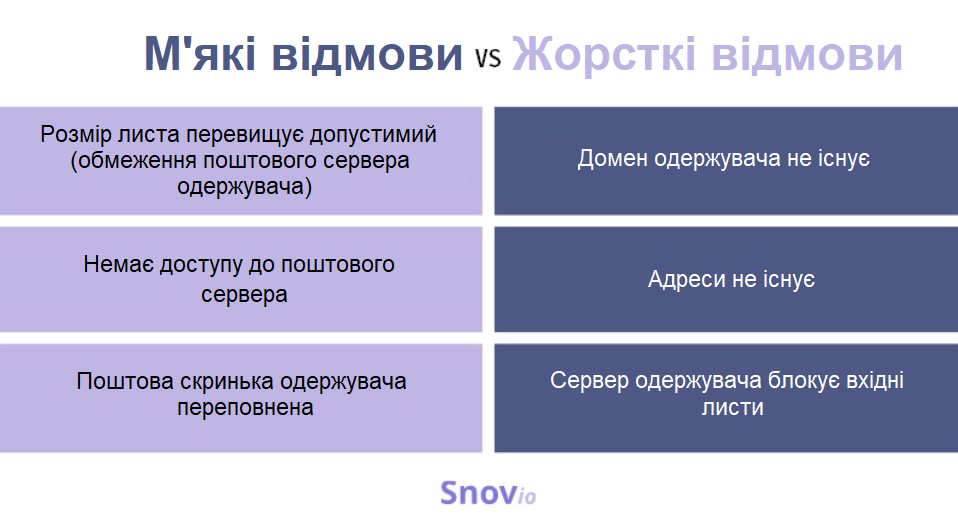Отже, ви нарешті зібрали список email-адрес для розсилки. Але як перевірити, чи існує пошта ваших потенційних клієнтів насправді? Вирішення цього завдання дозволить зберігати актуальність проспект-листів, регулярно збільшувати кількість доставлених листів та знижувати показник відмов, за яким визначається репутація відправника.
Досвідчені маркетологи добре розуміють, що перевірка емейл контактів — найважливіший, після лідогенерації, елемент email-маркетингу та продажів. Саме тому ми вирішили детально розповісти про те, чому нехтувати цією процедурою дуже ризиковано.
Зміст:
Верифікація email: що це і чим вона відрізняється від валідації адрес
Знали б ви тільки, скільки часу та зусиль мені знадобилося, щоб з’ясувати, чому перевірити пошту та валідувати її — не одне і те саме. Хоча, майже в кожному блозі та на більшості сайтів ці поняття використовуються як синоніми. Однак, різниця між ними все ж таки є, і вона важлива.
Email-верифікація — це процес перевірки адреси на існування та активність, тобто на дійсність. Тільки справжня поштова скринька може приймати листи. Професійна верифікація пошти за допомогою спеціальних сервісів — глибинна перевірка емейл відразу на декількох рівнях. Найчастіше мова йде про перевірки синтаксису, домену, MX-запису, статусу catch-all та пінгування електронної пошти (докладніше про ці процеси ви дізнаєтеся далі в статті).
А от валідація email ― це кінцевий результат перевірки (верифікації), який надається користувачу. У підсумку валідність поштових адрес можна зрозуміти з їхніх статусів: «дійсний», «недійсний» та «неверифікуємий» (задля наочності вони позначаються зеленим, жовтим та червоним кольорами відповідно). Іноді, верифікація та валідація пошти також передбачають перевірку будь-якої додаткової інформації про адресу або пошук джерела контакту.

Чому не слід нехтувати перевіркою пошти
Якщо у вас є сумніви в тому, чи потрібна перевірка пошти на існування, я назву кілька причин, які їх розвіють. Крім того, я поясню, чому ігнорування цього процесу може призвести до катастрофічних проблем з холодною розсилкою, на вирішення яких можуть піти тижні, та вам скоріш за все потрібно буде змінити емейл відправника.
Причина 1: збереження актуальності адрес у проспект-листах
Щорічно 22,5% email-адрес стають недійсними. І в цьому ніхто не винен — їх актуальність втрачається за об’єктивних обставин. Найчастіше самі власники поштових скриньок змінюють місце роботи, в результаті чого їх корпоративні адреси деактивуються.
Відповідно, нерегулярна верифікація — це прямий шлях до того, що через рік показник відмов по ваших розсилках складе 22,5%, що перевищує допустимий рівень у десять разів. Через це ваша репутація на поштових сервісах серйозно постраждає.
Тому експерти наполегливо рекомендують перевіряти список адрес для розсилки хоча б раз в два місяці.
Причина 2: зниження кількості жорстких відмов
Жорстка відмова (hard bounce) — це повернення листа відправнику через те, що адреса електронної пошти одержувача невалідна, тобто її просто не існує. Високий показник відмов (bounce rate) зазвичай вказує на спамерів, тому email-сервіси не особливо прихильні до таких відправників. Коли ваш bounce rate зростає — ваша репутація знижується. Як тільки він перевищить критичний поріг, ваша поштова адреса потрапить до чорного списку.

Причина 3: підвищення доставляємості електронної пошти
Використовуючи професійний email verifier задля перевірки пошти своїх лідів, ви можете відфільтрувати недійсні адреси, що надасть вам гарантію валідності тих, що залишилися. Валідні контакти точно зможуть приймати ваші листи, завдяки чому показник доставляємості (inbox placement rate) ваших розсилок залишиться високим. Це допоможе економити робочі ресурси та, знову ж таки, зберігає вашу репутацію відправника. До речі…
Причина 4: збереження високої репутації відправника
Ваша репутація на поштових сервісах залежить від ряду показників. Ми вже згадували bounce rate та inbox placement rate, але крім них також враховується те, наскільки часто ваші листи відправляють у спам та які ваші звички відправника (не забувайте розігрівати свої нові email акаунти!). Регулярне використання верифайерів у маркетингу та продажах допоможе вам перевіряти існування пошти ваших лідів заздалегіть. Таким чином можна уникнути попадання до чорних списків та підтримувати високу репутацію.
Як перевірити валідність електронної пошти
Є багато способів перевірки поштових адрес. Однак, деякі з них не дуже ефективні, а інші можуть бути практичні тільки у випадках, коли вам потрібно перевірити електронну адресу одного або декількох контактів.
Спосіб 1: Відправте тестовий лист
Це базова тактика, але ми не рекомендуємо використовувати її, якщо вам потрібно перевірити багато поштових скриньок. Коли ви відправляєте листа електронною поштою на фейкову або недійсну адресу, він повертається, і ви отримуєте повідомлення про невиконану операцію.

Але пам’ятайте, що якщо перевірити електронну пошту таким чином, це може збільшити bounce rate і завдати шкоди вашій репутації. Надалі це може призвести до додавання ваших розсилок до спаму, що помітно зіпсує їх показники. Як обійти це обмеження? Ви можете використовувати іншу пошту та відправляти тестові листи з неї.
Спосіб 2: знайдіть адресу у Google
Безумовно, цей метод не дозволить розпізнати фейкову адресу, але допоможе з’ясувати, чи дійсно вона публічна. Сьогодні власники поштових скриньок залишають їх літерально усюди: на сайтах знайомств, у соцмережах та на форумах. Якщо вам потрібно перевірити адресу тільки декількох контактів, цей метод може виявитися досить ефективним та не зашкодить репутації вашого домену.

Спосіб 3: перевірте зв’язок з сервером
Ви можете пропінгувати поштовий сервер та дізнатися, чи дійсна адреса, за допомогою таких інструментів, як PuTTY або Telnet. Але будьте обережні: не дивлячись на те, що цей метод досить точний, він вельми складний та може бути небезпечний для вашої програмної інфраструктури.
Спосіб 4: використовуйте верифайер
Найкращий спосіб перевірити електронні пошти — використовувати профільне ПЗ, що дозволяє провести верифікацію усього за пару кліків. Такі інструменти можуть відрізнятися функціоналом та допустимою кількістю адрес на одноразову перевірку, але всі вони однозначно спрощують та прискорюють верифікацію.
Як працює email-верифайер
Професійна перевірка email на валідність за допомогою профільних сервісів поєднує безліч технічних нюансів. Загальна ідея полягає в тому, що email-тестер виконує перевірку в повній відповідності до алгоритмів розробників. Наприклад, наш Email Verifier домагається максимальної точності результату за рахунок верифікації електронної пошти у 7 етапів, серед яких:
- Перевірка синтаксису
- Перевірка адреси на випадковий набір символів
- Перевірка існування домену
- Перевірка MX-запису
- Перевірка статусу catch-all домену
- SMTP-аутентифікація (пінгування адреси)
- Перевірка на freemail
А ось 5 найпоширеніших способів того, як відбувається перевірка електронної пошти на існування за допомогою більшості професійних верифайерів:
1. Перевірка формату адреси
При написанні професійного електронного листа ви напевно користуєтеся сервісами на зразок OnlineCorrector, щоб перевірити текст і переконатися, що кожне слово і всі розділові знаки написані правильно та доречно.
Програмна перевірка на написання адреси за допомогою профільних сервісів робить те ж саме. Алгоритми верифікації синтаксису виконують:
- Перевірку відповідності стандартам email-кореспонденції: виділення локальної частини адреси, наявність “равлика” ( @ ) та доменного імені з крапкою ( . )
- Підрахунок символів: у локальній частині допускається не більше 64 знаків
- Перевірку корректного розміщення крапок ( . ) та “равликів” ( @ )
- Перевірку правильного розміщення спеціальних символів: ? “ # $ % & ` * + – _ . / | \ ^ {} ~ (вони можуть використовуватися тільки всередині локальної частини адреси і ніколи — на початку або наприкінці, про що докладно написано тут)
2. Перевірка поштової скриньки за доменом
Ім’я домену пишеться відразу після символу @ і вказує на те, до якого домену відноситься електронна адреса вашого контакту. Наприклад, в адресі pauline@bombom.com частина bombom.com — це доменне ім’я. Верифайери перевіряють коректність його написання та наявність такого домену взагалі.
Така перевірка валідності email важлива по одній простій причині — термін дії сайтів з прив’язаними до них доменами закінчується, як і термін дії адрес, які відносяться до них. Деякі компанії йдуть з ринку, а деякі створюють поштові сервіси з новими доменами.
3. Catch-all перевірка
У деяких випадках коректно перевірити email неможливо, оскільки адреса прив’язана до домена з функцією catch-all. Це особливий тип доменів (відомих також як “неверифікуємі”), які приймають листи, спрямовані навіть на фейкові прив’язані до них адреси.

Наприклад, функція catch-all активна на доменному імені natwest.com. У локальній частині адреси ви можете написати будь-який випадковий набір символів, додати до нього @natwest.com, і ваш лист все одно буде успішно відправлено. Відповідно, усі адреси, пов’язані з цим доменним ім’ям, будуть приймати пошту. Але регулярні розсилки по них все ж можуть призвести до жорстких відмов, бо catch-all домени часто переналаштовуються, щоб позбавити користувачів небажаної кореспонденції.
Коли ви перевіряєте електронні адреси надійними верифайерами, ви можете розпізнати їх прив’язку до catch-all домену та запобігти поверненню листів. Якщо ви бачите, що адреса позначена як неверифікуєма, ви на особистий страх і ризик вирішуєте, чи варто відправляти на нього повідомлення, чи може краще видалити його зі списку розсилки раз і назавжди.
4. Перевірка MX-запису
Кажучи доступною мовою, запис MX вказує на поштовий сервер, який відповідає за прийом листів певним доменом. Її перевірка — досить складний, але точний спосіб визначити фейкову або неактивну адресу. Верифікація MX-запису, що зазначено в адресі, дозволяє зрозуміти, чи є ваш контакт реальною адресою, яка повинна бути дійсною, зареєстрованою та розміщенною. Та насамперед, повинна існувати можливість отримати до неї доступ.
Цей спосіб перевірки є обов’язковим та загальним для всіх верифайєрів. Тут є безліч специфічних технічних нюансів, але перевірка MX-запису безумовно дозволяє отримати більш детальну валідацію.
5. Пінгування адреси
Ще один спосіб перевірити існування пошти, що складається у відправці луна-запиту на email. Завдяки цьому можна дізнатися, чи здатна адреса отримувати повідомлення та реагувати на них. Пінгування скриньки також відомо як SMTP-авторизація. Якщо на такий запит приходить корректна відповідь, адреса вважається активною, тобто ви можете безпечно відправляти на неї листи.
Що далі? Збагачення бази контактів
Як бачите, перевірка email на існування здається складною лише у теорії. Саме тому варто використовувати email checker, адже такий сервіс вже давно вміє детально та комплексно верифікувати пошту усього за пару кліків!
Користуючись цими рішеннями ви можете бути впевнені, що ваші проспект-листи включають справжні, дійсні адреси, на які можна відправляти листи. Крім того, на таких сервісах можливо здійснювати масову перевірку email на існування, і тут ви гарантовано не перевищите показник відмов, зможете зберегти вашу репутацію відправника на високому рівні та підвищите показник доставляємості до 98%.
Що далі? Саме час взятися за збагачення клієнтської бази та персоналізацію своїх email-кампаній. Це надійний спосіб збільшення продажів та підвищення лояльності до вашого бренду!
Нехай щастить!
Залишилися питання про перевірку електронної пошти на які ми не відповіли у цій статті? Залиште нам коментарі під текстом і ми додамо цікаву для вас інформацію!



